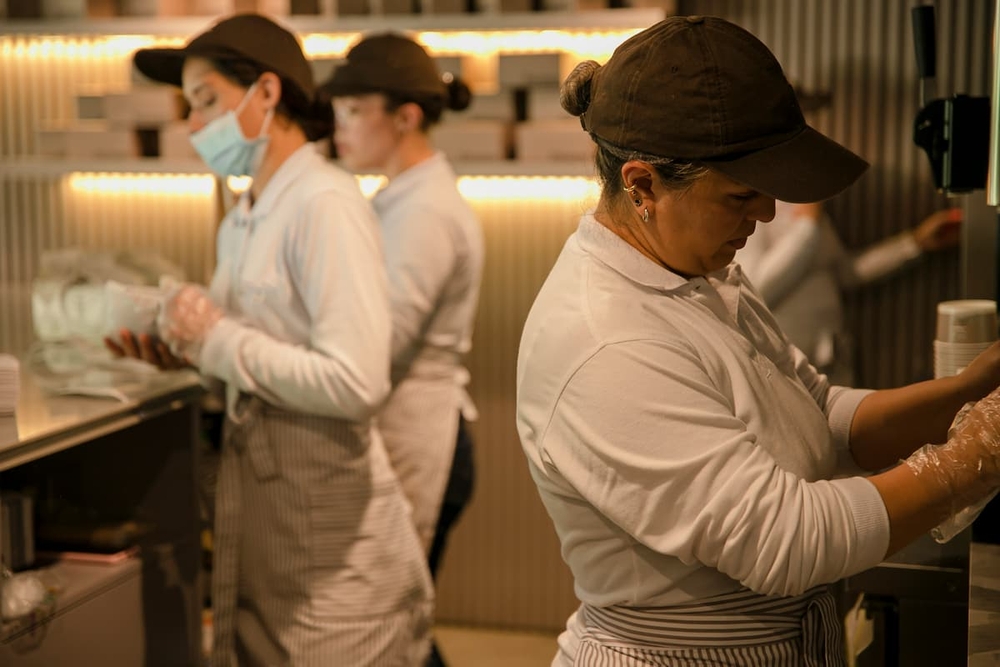Common health code violations in restaurants and how to fix them
Table of Contents
CloudKitchens
How many tacos can be delivered from a 1000sqft restaurant?
The same amount as a 200sqft ghost kitchen.
Maintaining a clean and safe restaurant environment is crucial for customer satisfaction, food safety, and legal compliance. Health code violations not only pose health risks but can also result in hefty fines, temporary closures, or even permanent shutdowns.
Additionally, violations can severely damage a restaurant’s reputation, leading to loss of customer trust and reduced revenue. Understanding the most common health code violations and taking proactive steps to prevent them is essential for ensuring a safe dining experience and long-term business success.
What are health codes in restaurants?
Health codes are a set of regulations designed to maintain food safety and prevent contamination in restaurants. These codes are enforced by local health departments and cover various aspects of food handling, storage, employee hygiene, and overall cleanliness. Restaurants must adhere to these standards to pass health inspections and continue operating legally.
Failure to comply with health codes can result in severe penalties, including fines, temporary closures, or even permanent shutdowns. By staying informed about the most common health code violations, restaurant operators can implement preventive measures to maintain compliance.
To ensure compliance with restaurant health codes, implementing a Hazard Analysis and Critical Control Points (HACCP) plan is essential. An HACCP plan is a proactive food safety system that identifies, monitors, and controls potential hazards at critical points in food preparation, such as cooking, cooling, and storage.
By systematically preventing foodborne illnesses, this approach helps restaurants maintain high safety standards. Many health departments require HACCP plans as part of regulatory compliance, making them a key component of a restaurant’s food safety strategy.
Who creates the health code?
Health codes are established by federal, state, and local regulatory agencies. At the national level, the Food and Drug Administration (FDA) provides guidelines through the FDA Food Code, which serves as a model for state and local governments. State and municipal health departments then create specific regulations based on these guidelines, adapting them to local needs and conditions.
In addition to government agencies, industry organizations like the Centers for Disease Control and Prevention (CDC) and the United States Department of Agriculture (USDA) contribute to health and safety regulations that impact restaurants.
Who enforces restaurant health codes?
Restaurant health codes are enforced primarily by local health departments, which conduct routine inspections to ensure compliance with safety regulations. Health inspectors visit restaurants to evaluate cleanliness, food handling practices, equipment maintenance, and employee hygiene. If violations are found, inspectors may issue warnings, fines, or even shut down operations until corrections are made.
The frequency of inspections varies depending on the jurisdiction and type of establishment. Restaurants with previous violations or complaints from customers may face more frequent inspections.
Read more: Kitchen Incubators: The ultimate guide for food startups to growth
What happens during a restaurant health inspection?
During a restaurant health inspection, a certified health inspector visits the establishment to assess compliance with health codes. The inspection typically covers the following areas:
- Food storage and handling: Ensuring raw and cooked foods are properly stored and handled.
- Food temperatures: Checking that hot and cold foods are stored at safe temperatures.
- Cleanliness and sanitation: Evaluating kitchen surfaces, utensils, and dining areas.
- Employee hygiene: Verifying that employees follow proper handwashing and hygiene protocols.
- Pest control: Looking for signs of pest infestations and ensuring proper prevention methods are in place.
At the end of the inspection, the restaurant receives a report detailing any violations and required corrective actions. Restaurants with major violations may be re-inspected to confirm compliance.
Common restaurant health code violations (and how to fix them fast)
Here are ten of the most frequent health code violations and how to fix them:
1. Improper food storage
Violation: Storing raw meats above ready-to-eat foods can lead to cross-contamination and foodborne illnesses.
How to fix:
- Always store raw meats on lower shelves and use airtight containers.
- Label and date all food items to ensure proper rotation using the First In, First Out (FIFO) method.
- Ensure refrigeration units maintain appropriate temperatures to prevent spoilage.
- Train staff on proper storage procedures to minimize risks.
2. Incorrect food temperatures
Violation: Failing to keep food at safe temperatures can lead to bacterial growth and foodborne illnesses.
How to fix:
- Use food thermometers to monitor temperatures.
- Keep cold food below 40°F and hot food above 140°F.
- Regularly check and calibrate thermometers.
- Train staff on the importance of temperature monitoring and food safety procedures.
Read more: From prep to profit: how to optimize food production in ghost kitchens
3. Poor personal hygiene
Violation: Employees not washing hands properly or not wearing gloves when handling food can lead to contamination.
How to fix:
- Implement strict handwashing policies and provide adequate handwashing stations.
- Require staff to wear gloves when necessary and change them regularly.
- Provide personal hygiene training and enforce a dress code that includes clean uniforms and hair restraints.
- Monitor employee hygiene practices and enforce compliance.
4. Unsanitary kitchen surfaces
Violation: Unclean countertops, cutting boards, and prep areas can harbor bacteria and spread contamination.
How to fix:
- Sanitize all surfaces regularly using approved disinfectants.
- Clean cutting boards after each use and replace worn-out ones.
- Implement a daily cleaning schedule to ensure all work areas remain free of bacteria and food debris.
- Assign cleaning responsibilities to specific employees to ensure accountability.
Read more: Restaurant Hiring/Staff 101: Comprehensive Guide
5. Pest infestations
Violation: The presence of rodents, cockroaches, or flies can result in immediate violations and food contamination.
How to fix:
- Conduct routine pest control inspections.
- Seal any gaps, keep food covered, and store garbage properly in sealed bins.
- Work with professional pest control services to implement a preventive pest management plan.
- Maintain a clean and clutter-free environment to reduce pest attraction.
6. Inadequate food handler training
Violation: Employees not following proper food safety procedures can increase contamination risks.
How to fix:
- Provide regular food safety training sessions.
- Require employees to obtain food handler certifications.
- Encourage ongoing education to keep staff updated on the latest safety protocols and best practices.
- Implement training refreshers to reinforce safe food handling habits.
Read more: How restaurant analytics can transform your operations
7. Cross-contamination
Violation: Using the same utensils for raw and cooked foods can spread harmful bacteria and cause foodborne illnesses.
How to fix:
- Implement color-coded cutting boards and utensils for different food groups.
- Train staff on the importance of avoiding cross-contact.
- Establish strict cleaning and sanitizing procedures between uses.
- Educate employees on the risks of cross-contamination and how to prevent it.
8. Dirty or malfunctioning equipment
Violation: Unclean ovens, refrigerators, and fryers can compromise food safety and lead to mechanical failures.
How to fix:
- Establish a cleaning schedule for all kitchen equipment.
- Conduct routine maintenance to ensure appliances function properly.
- Inspect equipment regularly for signs of wear and tear and replace as needed.
- Keep detailed maintenance logs to track necessary repairs.
9. Lack of proper labeling and dating
Violation: Expired or unlabeled food items increase the risk of serving spoiled food and failing inspections.
How to fix:
- Label all food containers with the date they were prepared and their expiration date.
- Implement a daily inventory check to discard expired items.
- Train employees on the importance of proper food labeling and organization.
- Establish clear policies for food expiration and rotation to avoid food waste and contamination.
10. Blocked handwashing sinks
Violation: Using handwashing sinks for storage or failing to provide soap and towels can prevent proper hand hygiene.
How to fix:
- Keep sinks clear and well-stocked with soap and disposable towels.
- Train staff to use them exclusively for handwashing.
- Conduct regular inspections to ensure compliance with handwashing station regulations.
- Post clear signage to remind staff of proper handwashing procedures.
How CloudKitchens can help
Avoiding health code violations is essential for running a successful restaurant. By implementing proper food handling practices, maintaining cleanliness, and training staff regularly, restaurant operators can prevent violations and ensure compliance with health regulations. Staying proactive and conducting regular self-inspections can help restaurants avoid potential fines and closures.
At CloudKitchens, we offer optimized kitchen solutions that make compliance with health codes easier. Our facilities are designed with food safety in mind, ensuring that your restaurant meets all regulatory requirements.
Want to operate a safe and efficient kitchen? Learn more about CloudKitchens today!
DISCLAIMER: This information is provided for general informational purposes only and the content does not constitute an endorsement. CloudKitchens does not warrant the accuracy or completeness of any information, text, images/graphics, links, or other content contained within the blog content. We recommend that you consult with financial, legal, and business professionals for advice specific to your situation.
More insights & stories
There’s more where that came from.
Get in the know and check out our additional insights


